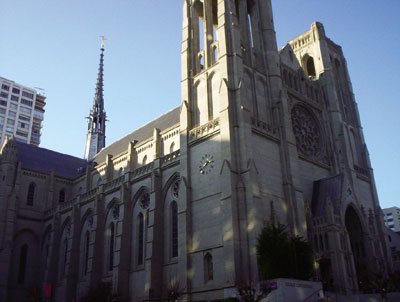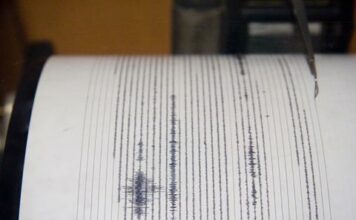A century isn’t such a long time in Europe (or even on the East
Coast of the U.S.). But few buildings in California, on the western
edge of the American continent, can claim that much history.
A century isn’t such a long time in Europe (or even on the East Coast of the U.S.). But few buildings in California, on the western edge of the American continent, can claim that much history.
Recently the Board of Directors of the San Francisco Chapter of the American Institute of Architects created a list of “San Francisco’s Top 25 Buildings,” and in the religion category listed Grace Cathedral, an Episcopal church which has had a rich history and continues to play an important role in the civic and religious life of San Franciscans.
Its story begins with the devastating earthquake and fire that destroyed much of the city in 1906. In the spring of the following year, as reconstruction projects began to spring up everywhere, local Episcopalians began planning for a great Gothic-style church to be built on the donated property where two mansions belonging to the Crocker family had been destroyed, near the summit of Nob Hill.
The foundation stone was laid in 1910, but it wasn’t until 1928 that work began in earnest. Then the Great Depression and World War II stopped construction. Finally, in 1964, the cathedral was completed and consecrated during a service televised throughout the Bay Area.
Grace Cathedral is hosting many events this year to mark its centenary: concerts, a film series, guest speakers. But one of the most important is the only Northern California exhibition during the North American tour of the Keiskamma Altarpiece.
An altarpiece is a picture or relief representing a religious subject and suspended in a frame on or behind an altar (or Communion Table) in a church. This huge work of art (13-by-22 feet) was created by 120 women in Hamburg – South Africa’s Eastern Cape Province. Multiple hinged panels open outward, revealing pictorial stories of the community’s struggles with the AIDS epidemic.
The altarpiece was brought to the U.S. by the UCLA Aids Institute and the Art/Global Health Center at UCLA in 2006. The national tour began at St. James Cathedral in Chicago and will leave San Francisco on May 20 for stops in other U.S. cities.
Grace Cathedral has many other interesting things to see during a visit to San Francisco:
n At the church’s main entrance on Taylor Street are faithful replicas of the Doors of Paradise by Lorenzo Ghiberti. Completed in 1452, the originals lead to the baptistry of the duomo in Florence, Italy. During World War II they were taken down and hidden; plaster molds were made as a precaution in case they were destroyed. These gilded bronze doors in San Francisco were produced from these molds and are considered more accurate representations of their biblical scenes than the weather-worn originals in Florence.
n Reflecting the struggles of the Bay Area against the AIDS epidemic, the cathedral houses a unique Interfaith AIDS Memorial Chapel. In 1990 artist Keith Haring carved an altarpiece representing the Life of Christ, which was cast in bronze after his death. The 81-by 60-inch, three-panel sculpture is now the focal point of a chapel, which also houses rotating panels of the AIDS Memorial Quilt.
n After a recent renovation of the cathedral grounds, visitors are invited to walk a 40-foot-diameter Labyrinth, an outdoor terrazzo stone pathway of circles and spirals that is based on an 800-year-old structure on the floor of Chartres Cathedral in France. Many people find it spiritually refreshing to meditate or pray while walking from the outer edge to the center and back again, meanwhile enjoying scenic views of Huntington Park and the Financial District skyline.
Grace Cathedral is located at 1100 California Ave. Public parking is available in a nearby underground garage. For more information, call (415) 749-6300 or visit www.gracecathedral.org.














